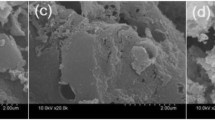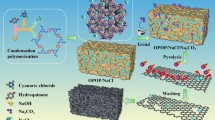Abstract
Porous carbons with high specific area surfaces are promising electrode materials for supercapacitors. However, their production usually involves complex, time-consuming, and corrosive processes. Hence, a straightforward and effective strategy is presented for producing highly porous carbons via a self-activation procedure utilizing zinc gluconate as the precursor. The volatile nature of zinc at high temperatures gives the carbons a large specific surface area and an abundance of mesopores, which avoids the use of additional activators and templates. Consequently, the obtained porous carbon electrode delivers a satisfactory specific capacitance and outstanding cycling durability of 90.9% after 50000 cycles at 10 A·g−1. The symmetric supercapacitors assembled by the optimal electrodes exhibit an acceptable rate capability and a distinguished cycling stability in both aqueous and ionic liquid electrolytes. Accordingly, capacitance retention rates of 77.8% and 85.7% are achieved after 50000 cycles in aqueous alkaline electrolyte and 10000 cycles in ionic liquid electrolyte. Moreover, the symmetric supercapacitors deliver high energy/power densities of 49.8 W·h·kg−1/2477.8 W·kg−1 in the Et4NBF4 electrolyte, outperforming the majority of previously reported porous carbon-based symmetric supercapacitors in ionic liquid electrolytes.

Similar content being viewed by others
References
Poonam S K, Arora A, Tripathi S K. Review of supercapacitors: materials and devices. Journal of Energy Storage, 2019, 21: 801–825
Qin Y, Liao Y, Liu J, Tian C, Xu H, Wu Y. Research progress of wood-derived energy storage materials. Journal of Forestry Engineering, 2021, 6(5): 1–13 (in Chinese)
Jin Z, Yang L, Shi S, Wang T, Duan G, Liu X, Li Y. Flexible polydopamine bioelectronics. Advanced Functional Materials, 2021, 31(30): 2103391
Chen Y, Zhang Q, Chi M, Guo C, Wang S, Min D. Preparation and performance of different carbonized wood electrodes. Journal of Forestry Engineering, 2022, 7(3): 127–135 (in Chinese)
Yu J, Liu S, Duan G, Fang H, Hou H. Dense and thin coating of gel polymer electrolyte on sulfur cathode toward high performance Li-sulfur battery. Composites Communications, 2020, 19: 239–245
Gonzalez A, Goikolea E, Barrena J A, Mysyk R. Review on supercapacitors: technologies and materials. Renewable & Sustainable Energy Reviews, 2016, 58: 1189–1206
Wang G P, Zhang L, Zhang J J. A review of electrode materials for electrochemical supercapacitors. Chemical Society Reviews, 2012, 41(2): 797–828
Guo W, Guo X, Yang L, Wang T, Zhang M, Duan G, Liu X, Li Y. Synthetic melanin facilitates MnO supercapacitors with high specific capacitance and wide operation potential window. Polymer, 2021, 235: 124276
Han Z, Zhong W, Wang K. Preparation and examination of nitrogen-doped bamboo porous carbon for supercapacitor materials. Journal of Forestry Engineering, 2020, 5(5): 76–83 (in Chinese)
Wang Y, Zhang L, Hou H, Xu W, Duan G, He S, Liu K, Jiang S. Recent progress in carbon-based materials for supercapacitor electrodes: a review. Journal of Materials Science, 2021, 56(1): 173–200
Yang L, Guo X, Jin Z, Guo W, Duan G, Liu X, Li Y. Emergence of melanin-inspired supercapacitors. Nano Today, 2021, 37: 101075
Han X, Xiao G, Wang Y, Chen X, Duan G, Wu Y, Gong X, Wang H. Design and fabrication of conductive polymer hydrogels and their applications in flexible supercapacitors. Journal of Materials Chemistry A: Materials for Energy and Sustainability, 2020, 8(44): 23059–23095
You B, Wang L L, Yao L, Yang J. Three dimensional N-doped graphene-CNT networks for supercapacitor. Chemical Communications, 2013, 49(44): 5016–5018
Wang W, Lv H, Du J, Chen A. Fabrication of N-doped carbon nanobelts from a polypyrrole tube by confined pyrolysis for supercapacitors. Frontiers of Chemical Science and Engineering, 2021, 15(5): 1312–1321
Cheng Y L, Huang L, Xiao X, Yao B, Yuan L Y, Li T Q, Hu Z M, Wang B, Wan J, Zhou J. Flexible and cross-linked N-doped carbon nanofiber network for high performance freestanding supercapacitor electrode. Nano Energy, 2015, 15: 66–74
Faraji S, Ani F N. The development supercapacitor from activated carbon by electroless plating—a review. Renewable & Sustainable Energy Reviews, 2015, 42: 823–834
Wang N, Huang X, Zhang L, Hu J, Chao Y, Zhao R. Pyrolysis transformation of ZIF-8 wrapped with polytriazine to nitrogen enriched core-shell polyhedrons carbon for supercapacitor. Frontiers of Chemical Science and Engineering, 2021, 15(4): 944–953
Hao P, Zhao Z H, Tian J, Li H D, Sang Y H, Yu G W, Cai H Q, Liu H, Wong C P, Umar A. Hierarchical porous carbon aerogel derived from bagasse for high performance supercapacitor electrode. Nanoscale, 2014, 6(20): 12120–12129
Wang H, Niu H T, Wang H J, Wang W Y, Jin X, Wang H X, Zhou H, Lin T. Micro-meso porous structured carbon nanofibers with ultra-high surface area and large supercapacitor electrode capacitance. Journal of Power Sources, 2021, 482: 228986
Song M Y, Zhou Y H, Ren X, Wan J F, Du Y Y, Wu G, Ma F W. Biowaste-based porous carbon for supercapacitor: the influence of preparation processes on structure and performance. Journal of Colloid and Interface Science, 2019, 535: 276–286
Ai T, Wang Z, Zhang H R, Hong F H, Yan X, Su X H. Novel synthesis of nitrogen-containing bio-phenol resin and its molten salt activation of porous carbon for supercapacitor electrode. Materials, 2019, 12(12): 1986
Dai J D, Wang L L, Xie A, He J S, Yan Y S. Reactive template and confined self-activation strategy: three-dimensional interconnected hierarchically porous N/O-doped carbon foam for enhanced supercapacitors. ACS Sustainable Chemistry & Engineering, 2020, 8(2): 739–748
Dat N T, Tran T T V, Van C N, Vo D V N, Kongparakul S, Zhang H B, Guan G Q, Samart C. Carbon sequestration through hydrothermal carbonization of expired fresh milk and its application in supercapacitor. Biomass and Bioenergy, 2020, 143: 105836
Dong D, Zhang Y S, Wang T, Wang J W, Romero C E, Pan W P. Enhancing the pore wettability of coal-based porous carbon as electrode materials for high performance supercapacitors. Materials Chemistry and Physics, 2020, 252: 123381
Dong D, Zhang Y S, Xiao Y, Wang T, Wang J W, Gao W. Oxygen-enriched coal-based porous carbon under plasma-assisted MgCO3 activation as supercapacitor electrodes. Fuel, 2022, 309: 122168
Chen J, Xiao G, Duan G, Wu Y, Zhao X, Gong X. Structural design of carbon dots/porous materials composites and their applications. Chemical Engineering Journal, 2021, 421: 127743
Kong D B, Qin C Y, Cao L, Fang Z M, Lai F L, Lin Z D, Zhang P, Li W, Lin H J. Synthesis of biomass-based porous carbon nanofibre/polyaniline composites for supercapacitor electrode materials. International Journal of Electrochemical Science, 2020, 15(1): 265–279
Liu N. Influence of ZnCl2 activation on structure and electrochemical performance of carbon aerogel spheres. Acta Physico-Chimica Sinica, 2013, 29(3): 551–556 (in Chinese)
Zhang Q, Yan B, Feng L, Zheng J, You B, Chen J, Zhao X, Zhang C, Jiang S, He S. Progress in the use of organic potassium salts for the synthesis of porous carbon nanomaterials: microstructure engineering for advanced supercapacitors. Nanoscale, 2022, 14(23): 8216–8244
Lee K S, Seo Y J, Jeong H T. Capacitive behavior of functionalized activated carbon-based all-solid-state supercapacitor. Carbon Letters, 2021, 31(5): 1041–1049
Peng C, Zeng T Q, Kuai Z Y, Li Z F, Yu Y, Zuo J T, Jin Y, Wang Y H, Li L. A self-activation green strategy to fabricate N/P Co-doped carbon for excellent electrochemical performance. Journal of the Electrochemical Society, 2019, 166(14): A3287–A3293
Rufford T E, Hulicova-Jurcakova D, Khosla K, Zhu Z H, Lu G Q. Microstructure and electrochemical double-layer capacitance of carbon electrodes prepared by zinc chloride activation of sugar cane bagasse. Journal of Power Sources, 2010, 195(3): 912–918
Sandhiya M, Nadira M P, Sathish M. Fabrication of flexible supercapacitor using N-doped porous activated carbon derived from poultry waste. Energy & Fuels, 2021, 35(18): 15094–15100
Wu X, Ding B, Zhang C, Li B, Fan Z. Self-activation of nitrogen and sulfur dual-doping hierarchical porous carbons for asymmetric supercapacitors with high energy densities. Carbon, 2019, 153: 225–233
Yan D, Liu L, Wang X Y, Xu K, Zhong J H. Biomass-derived activated carbon nanoarchitectonics with hibiscus flowers for high-performance supercapacitor electrode applications. Chemical Engineering & Technology, 2022, 45(4): 649–657
Yang B B, Zhang D Y, He J J, Wang Y L, Wang K J, Li H X, Wang Y, Miao L, Ren R Y, Xie M. Simple and green fabrication of a biomass-derived N and O self-doped hierarchical porous carbon via a self-activation route for supercapacitor application. Carbon Letters, 2020, 30(6): 709–719
Wang T, Tan S, Liang C. Preparation and characterization of activated carbon from wood via microwave-induced ZnCl2 activation. Carbon, 2009, 47(7): 1880–1883
Yue Z, Mangun C L, Economy J. Preparation of fibrous porous materials by chemical activation: 1. ZnCl2 activation of polymer-coated fibers. Carbon, 2002, 40(8): 1181–1191
Yao L, Wu Q, Zhang P, Zhang J, Wang D, Li Y, Ren X, Mi H, Deng L, Zheng Z. Scalable 2D hierarchical porous carbon nanosheets for flexible supercapacitors with ultrahigh energy density. Advanced Materials, 2018, 30(11): 1706054
Shang Z, An X, Zhang H, Shen M, Baker F, Liu Y, Liu L, Yang J, Cao H, Xu Q, Liu H, Ni Y. Houttuynia-derived nitrogen-doped hierarchically porous carbon for high-performance supercapacitor. Carbon, 2020, 161: 62–70
Wang H, Xu Z, Kohandehghan A, Li Z, Cui K, Tan X, Stephenson T J, King’ondu C K, Holt C M B, Olsen B C, Tak J K, Harfield D, Anyia A O, Mitlin D. Interconnected carbon nanosheets derived from hemp for ultrafast supercapacitors with high energy. ACS Nano, 2013, 7(6): 5131–5141
Zheng W, Halim J, Persson P O Å, Rosen J, Barsoum M W. MXene-based symmetric supercapacitors with high voltage and high energy density. Materials Reports: Energy, 2022, 2(1): 100078
Shao R, Niu J, Liang J, Liu M, Zhang Z, Dou M, Huang Y, Wang F. Mesopore- and macropore-dominant nitrogen-doped hierarchically porous carbons for high-energy and ultrafast supercapacitors in non-aqueous electrolytes. ACS Applied Materials & Interfaces, 2017, 9(49): 42797–42805
Wong S I, Lin H, Ma T, Sunarso J, Wong B T, Jia B. Binary ionic liquid electrolyte design for ultrahigh-energy density graphene-based supercapacitors. Materials Reports: Energy, 2022, 2(2): 100093
Acknowledgments
This work was financially supported by the starting grant from Jiangxi Normal University.
Author information
Authors and Affiliations
Corresponding authors
Electronic Supplementary Material
11705_2022_2250_MOESM1_ESM.pdf
Hierarchical porous carbon derived from one-step self-activation of zinc gluconate for symmetric supercapacitors with high energy density
Rights and permissions
About this article
Cite this article
Xiao, J., Zhang, H., Wang, Y. et al. Hierarchical porous carbon derived from one-step self-activation of zinc gluconate for symmetric supercapacitors with high energy density. Front. Chem. Sci. Eng. 17, 387–394 (2023). https://doi.org/10.1007/s11705-022-2250-3
Received:
Accepted:
Published:
Issue Date:
DOI: https://doi.org/10.1007/s11705-022-2250-3




